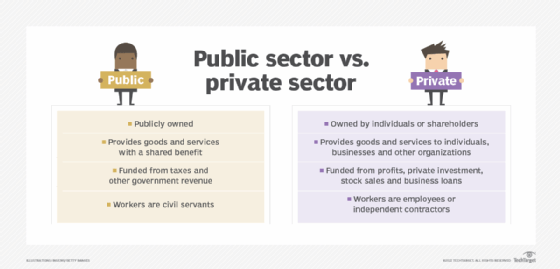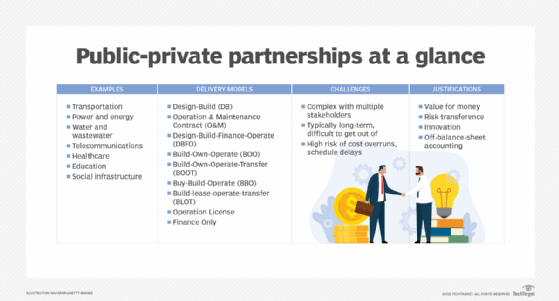private sector
What is the private sector?
The private sector is the part of a country's economic system that is run by individuals and companies, rather than a government entity. Most private sector organizations are run with the intention of making profit.
The part of the economy under control of the government is known as the public sector. Charities, non-governmental organizations (NGOs) and nonprofit organizations are a third segment of the economy, known as the volunteer sector or voluntary sector. However, such organizations are more commonly considered part of the private sector as they typically operate without government control or oversight.
Types of private sector businesses
Some different types of business structure in the private sector include the following:
- Sole proprietorships. These are businesses owned and operated by one person, and usually funded by personal finance. An individual who owns and runs a diner is a sole proprietor.
- These are businesses owned by two or more private individuals. Law firms and advertising agencies are often set up as partnerships.
- Small and midsize enterprises. Small to midsize businesses are defined by their revenue, assets, ownership structure and number of employees. The U.S. Small Business Administration (SBA) sets the number of employees for a small business at less than 500 employees. Medium-sized businesses have 500-2,000 employees, according to the SBA, and businesses with fewer than 10 employees are small office-home offices.
- Corporations and multinationals. A corporation is a separate legal entity from its owners. Corporations are owned by shareholders and elect a board of directors to supervise the organization's activities. Multinationals operate in multiple countries.
- Professional and trade associations. These groups serve people in a specific profession or industry. For example, the American Bar Association serves lawyers and sets standards for their field.
- Trade unions. A trade or labor union, like an association, is an organization that provides resources and services to members of a specific field, organization or company. They usually focus on relations between workers and the employer. Members of a union have a right to engage in collective bargaining with their employer. The International Union of Painters and Allied Trades is an example of a union, as is the new Amazon Labor Union.
Trade unions, professional associations and trade associations are usually nonprofits.
What is the role of the private sector?
The private sector plays a vital role in the economy by creating jobs, providing goods and services, and stimulating economic growth. It is an important source of tax revenue for governments. Businesses pay taxes to help to fund public services and enable governments to invest in infrastructure and other important projects.
The private sector is a key driver of innovation. Private companies invest in research and development, which leads to new products and services that boost the economy and improve people's lives. The invention of the iPhone is one example, as it revolutionized the way people communicate and carry out everyday tasks.
Private sector companies also collaborate with public sector and government to gain access to resources and develop new products. For example, at the 2021 Cybersecurity and Infrastructure Security Agency's National Cybersecurity Summit, private critical infrastructure companies asked the U.S. government to provide more cybersecurity threat information to defend assets in an expanding threat landscape.
How is the private sector regulated?
Regulations exist for a number of reasons, including consumer safety, product quality, safer working conditions, investor protection and competition laws. In the U.S., government agencies oversee and regulate the private sector. They create rules and regulations that businesses in specific industries such as healthcare, food and transportation must comply with. They also regulate areas such as workplace safety that affect most private sector entities.
Some examples of regulations include the following:
- The Food and Drug Administration makes rules related to the safety, efficacy and security of food, medical devices, veterinary products and drugs in the U.S.
- The Federal Communications Commission regulates interstate and international communications.
- The Occupational Safety and Health Administration makes rules related to ensuring safe, healthy working conditions and work environments.
- The International Organization for Standardization regulates many areas of business, including quality assurance and environmental practices.
In addition to these federal government and international regulatory bodies, businesses in the U.S. are subject to the laws of the states they operate in. Certain industries also create their own rules and standards. The IT industry is one example of this.
Private sector vs. public sector: Key differences explained
Several characteristics distinguish the public sector from the private sector, including the following:
- In the private sector, a business's primary objective is to make a profit. In the public sector, the primary objective is to provide goods and services that benefit the public.
- Part of public sector funding comes from taxes. Other public funds are generated in other ways; entities such as the U.S. Postal Service bring in revenue from the products and services they sell. Private companies fund themselves through revenue, selling shares of company ownership, private investment and loans.
- Public sector employees are called civil servants, and they work in the civil service. They are paid using tax dollars or revenue from fees. The private sector employs workers as employees, and they are paid from private funds.
- Private sector organizations are owned by individuals or private companies. Organizations in the public sector are owned by the public and managed by the government.

All of these characteristics can lead to operational and experiential differences. For example, public sector jobs may offer more job security and a more fixed route of promotion for employees.
The private sector is perceived as being quicker to adopt and develop new technologies than public sector organizations, but that isn't always the case. Collaboration between the two sectors helps bolster adoption of new technologies in the public sector.
What's the difference between the private sector and business sector?
The term business sector is often used as a synonym for private sector. Broadly, they are used to mean the same thing. There are differences in the nuances of using the terms, however.
Private sector
The term private sector puts an emphasis on ownership of an entity and where the funding is coming from. An organization can be privately owned by individuals, such as the founders of a company, or it can have a shared investment model through incorporation and the sale of stock.
Business sector
The term business sector puts an emphasis on the organization's output. It is used when the speaker wants to emphasize what the business provides or produces. The business sector can be divided into the following categories based on what is being produced:
- Primary sector creates the raw material that supports the other sectors. It includes industries like fishing, farming and forestry.
- Secondary sector transforms raw material into products. It includes manufacturing.
- Tertiary sector transports and sells the products created in the secondary sector.
- Quaternary sector consists of businesses that provide knowledge work and information services for future development. For example, businesses that provide artificial intelligence services for agriculture organizations fall into the quaternary sector.
How do the public and private sector work together?
In many countries, there is considerable overlap between the public and private sectors. Examples of enterprises that are often run cooperatively include waste management, water management, communications, education, transportation, healthcare and security services.
An industry or business may start out in one sector and move to the other. Turning over a public agency or function to private citizens or businesses is known as Privatization. In the U.S., several public services have been privatized in recent decades, including the following:
- airport operation
- corrections
- data processing
- motor vehicle customer service
- waste management
- water treatment
The opposite movement, from the private sector to the public sector, is known by various names, including nationalization and municipalization, depending on the level of government involved.
A public-private partnership is when various stakeholders from the public and private sectors work together, such as the U.S. response to the COVID-19 pandemic. The U.S. Department of Defense and the Department of Health and Human Services launched Operation Warp Speed (OWS) early in the pandemic, providing $18 billion in funding for the development of a vaccine. OWS shrunk a 73-month vaccine approval cycle down to just 18 months. As part of the program, government funding went to pharmaceutical companies like Pfizer and Moderna, as well as companies that provide other types of vaccine-related services, such as cell culture buffer manufacturers.

In IT, private sector companies are often subject to government regulations surrounding data collection and use. Learn the basics of the California Consumer Privacy Act and what it means for companies that handle consumer data.